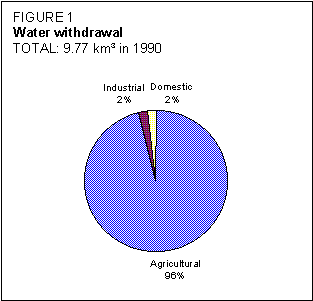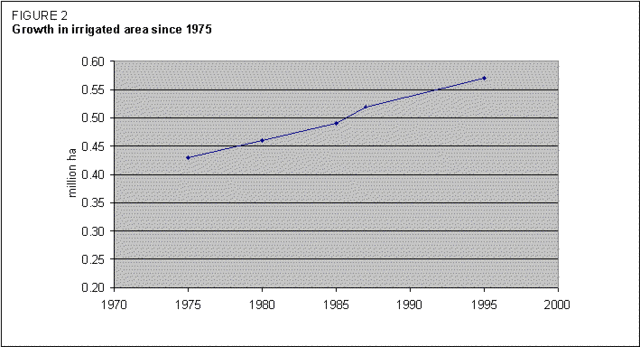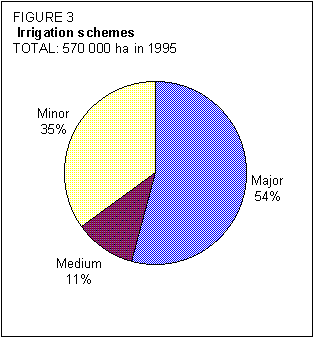Ilankai Tamil Sangam29th Year on the Web Association of Tamils of Sri Lanka in the USA |
|||
 Home Home Archives Archives |
Water Profile of Sri Lankaby The Encyclopedia of Earth, [last updated August 2008, accessed December, 2008]
Climate and Water Resources Climate The island receives rain mainly through two monsoons. The rainfallintensity varies markedly across the island. Based on rainfall, several agroclimatic regions (wet zone, intermediate zone, dry zone, and arid zone) can be recognized. Depending on the rainfall pattern, climatologists divide Sri Lanka's climatic year into five seasons:
There is considerable variation around the mean annual rainfall of 2,000 [[millimeter}s (mm). The highest rainfalls are in the central highlands. The maximum values are on the western slopes with several stations recording values exceeding 5,000 mm (Maliboda, 5,330 mm; Weweltalawa estate, 5,258 mm; and Kenilworth estate, 5,085 mm). The mean annual rainfall values on the eastern slopes are less than 3,500 mm and the lowest are in the northwest and southwest lowlands with a minimum value of 935 mm recorded at the Ambalantota gauging station. The mean annual temperature is about 27°C in the lowlands and 15°C in the central highlands. The temperature decreases with increasing altitude, approximately 2°C per 300 m of elevation. River Basins and Water Resources Sri Lanka's radial network of rivers begins in the central highlands. There are about 103 distinct river basins covering 90 percent of the island. The southwest quarter of the island has seven major basins with catchment areas ranging from 620 to 2,700 square kilometers (km2). They are: Kelani ganga (2,292 km2), Kalu ganga (2,719 km2), Maha oya (1,528 km2), Attanagalla oya (736 km2), Gin ganga (932 km2), Nilwala ganga (971 km2), and Bentota ganga (629 km2). An exception to the above radial pattern is the largest basin, that of the 335-km-long Mahaweli River which has a catchment area of 10,448 km2. After leaving the central highlands, it runs almost north for 90 kilometers (km) from Minipe to Manampitiya and a then further 70 km through several distributaries as far as Verugal and Mutur on the east coast. Most Sri Lankan river basins are small. Only 17 of the 103 basins exceed 1,000 km2. In addition to the Mahaweli basin, four others exceed 2,500 km2. Three of these (Deduru oya, Kala oya, and Malwatu oya) have their entire catchment are in the dry zone, and only Kalu ganga is in the wet zone. The total runoff in Sri Lanka is estimated at 49.2 cubic kilometers (km3/year). Groundwater resources have been extensively used since ancient times for domestic purposes using shallow open wells in almost all parts of the country. Sri Lanka's largest aquifer extends over 200 km in the northwestern and northern coastal areas. There are about 15,000 tube-wells in the country. The quality of the groundwater is generally fairly good and relatively constant throughout the year. However, in some parts of the country (northern and northwestern coastal areas) excessive concentrations of iron and nitrates (due to agrochemicals and fertilizers) have been reported. Furthermore, due to uncontrolled abstraction of groundwater for domestic and agricultural uses, brackish water intrusion has occurred in the coastal areas. In 1985, the internal renewable groundwater resources were estimated at 7.8 km3, most (estimated at 7 km3/year) returning to the river systems and being included in the surface water resources estimate. In 1991, the total internal renewable water resources of the country were estimated at 50 km3/year. Economic development, population pressure, and growing demands for food production, electric power, and adequate water and sanitation services are placing increasing pressure on water resources. It is predicted that by 2000 the demand for water will outstrip supply particularly in the country's dry zone where most irrigation schemes are located. DamsIn 1996, the total dams capacity was 5.942 km3. Dams in Sri Lanka are classed according to the materials they use. They are mainly earthen, rockfill, or concrete dams. Earthen dams are the most common type in Sri Lanka, the longest being the Parakrama Samudraya dam which is 13.5 km long and has a storage capacity of 0.12 km3. The highest in this category is the Senanayake Samudraya dam at 44 m and with a storage capacity of 0.95 km3. The Victoria dam, built under the Mahaweli multipurpose project, is the highest concrete (double curvature) dam with a height of 106 m and a storage capacity of 0.73 km3. The gross theoretical hydropower potential in Sri Lanka is estimated at 8,000 gigawatt hours per year (GWh/year). In 1997, 16 hydropower plants were in operation with an installed capacity of 1,103 megawatts (MW). Hydropower accounted for 81 percent of electricity generation in Sri Lanka. Water WithdrawalThe large-scale development of water resources for irrigation and hydropower has progressed rapidly in the last 50 years. In Sri Lanka, the quantities of water required for industrial and domestic uses are low compared to irrigation and hydropower. In 1990, water withdrawal for agricultural activities was estimated at 9.38 km3. The corresponding values for domestic and industrial activities were 0.195 km3 each (Figure 1). 
Groundwater is an important source of water for irrigation and domestic use. It is increasingly used as drinking water, especially in small towns and rural areas. The total water demand for 2000 is estimated to be 10.92 km3. Of this total, 90 percent will be for agriculture, 7 percent for domestic purposes and 3 percent for industrial purposes. The supply of drinkable water to communities is in the early stages of development. In 1992, 53 percent of the population (87 percent of the urban and 49 percent of the rural population) had access to safe drinking water. The other inhabitants were using unprotected wells, rivers, and tanks. High incidences of waterborne sickness (120,000 recorded hospitalizations per year for diarrhea) indicate that a serious water quality problem exists. The Government has placed a high priority on providing water supply to urban communities where groundwater is contaminated. The Government spends about US$45.0 million/year in providing piped water to the population. Sri Lanka's only public sewer system is in Colombo. It serves about 20 percent of the Colombo metropolitan region and the collection is not treated. Only very few industries have treatment plants whilst others discharge straight to waterways. Irrigation and Drainage DevelopmentIrrigation activities in Sri Lanka date back 2,500 years. Initially, these activities started with the small-scale village tank and simple channel system. Later these were developed (275 AD to 1186 AD) so that river flows across shallow valleys could be intercepted to build large reservoirs, or water flowing down perennial rivers was diverted by weirs and conveyed through long excavated canals to be impounded in large reservoirs at appropriate locations to supply large areas of land. However, most of these systems fell into disuse and were abandoned after the twelfth century. In the nineteenth century, some of the tanks, such as those at Kalawewa, Tissawawe, and Kantale, were restored. In 1857, irrigation ordinance was introduced in order to give legislative status to the rules governing irrigation activity. In 1952, Gal oya, a large multipurpose scheme was launched, followed in the 1960s by Mahaweli, the largest multipurpose scheme. These multipurpose projects aimed not only at irrigation development and settlement but also at hydropower generation. The Mahaweli project, which is by far the largest government project in the country, envisaged the development of more than 300,000 hectares (ha) of new irrigated land and the generation of 800 megawatts (MW) of hydropower at the completion of the project. The Land Reform Act of 1972 limits the private ownership of land to a per caput ceiling of 10 ha for paddy; 20 ha for tea, rubber and coconut; and 0.2 ha for residents. This act also established a land reform commission with the power to acquire and dispose of properties. Given the state of irrigation development in the country and the present level of technology in agriculture and in construction engineering, little economic potential is left to be exploited by new irrigation construction. Hence, it is reasonable to assume that the country has reached its irrigation potential. Studies have revealed that the cost-benefit ratio of investments in irrigation construction fell sharply in the early 1980s and hit a record low in 1986. In 1995, the total irrigated land area of the country was 570,000 ha. This showed that around 30 percent of the cultivated land in the country was irrigated. From 1963 to 1993, the area irrigated by major irrigation schemes increased by about 110 percent, mainly due to major irrigation projects implemented by the Government. The total water managed area has increased by 17 percent during the past ten years (Figure 2).  The irrigation systems in Sri Lanka are designed solely for paddy cultivation. In 1994, the total harvested irrigated area for paddy was 661,700 ha and the average irrigated yield for paddy was 3.3 tons per hectare (t/ha). In 1991, it was reported that 15,000 ha of chilies were grown under irrigated conditions. Other crops grown under irrigated conditions are sweet potato, banana, and green gram. In Sri Lanka, irrigation schemes can b classed as minor, medium or major depending on the area they serve (Figure 3). Minor schemes provide facilities for less than 80 ha. In 1995, they served about 200,000 ha. Medium schemes provide facilities for areas of 80-400 ha. In 1995, they served 61,000 ha. Major schemes provide facilities for more than 400 ha. In 1995, they served 309,000 ha. 
Storage schemes have two purposes: storage and flood control. Water is impounded in these tanks by building dams across valleys, and then released when required to service areas downstream. Diversion weirs, commonly called anicuts, are constructed in perennial streams in the wet zone to convey water to the fields below. Here, a masonry or concrete wall is built across the stream to head up and divert water. The diverted water is distributed to the fields by gravity. In the wet zone, flood control and drainage schemes have been incorporated into the irrigation system mainly in the lower reaches of rivers. In the coastal areas, saltwater exclusion schemes have been commissioned where water salinity affects agriculture. Flood bunds and pumps are the main features in flood protection schemes, whereas gated regulators are adopted in saltwater exclusion schemes. Lift irrigation schemes with mechanically or electrically operated pumps have been introduced recently to irrigate the highlands. It is estimated that around 1,000 ha are irrigated by groundwater wells. Surface irrigation dominates in Sri Lanka. The main irrigation methods adopted in Sri Lanka are basin and furrow irrigation. In 1980, an attempt was made to establish a water tax. However, this attempt failed because of the political unrest in the 1980s, a lack of policy concerning the operation and maintenance (O&M) budget, and a lack of coordination between the various agencies in charge of irrigation. In 1985, the average cost of developing major surface irrigation schemes was US$1,350/ha. In 1993, the average O&M cost for a major surface irrigation scheme such as Kaudulla was US$12/ha/year. Irrigation development, O&M and rehabilitation have been predominantly state activities. However, in the 1970s, participatory approaches were incorporated in certain irrigation rehabilitation projects. In the period 1981-1983, a national program of water management was initiated in 24 major systems covering about 80,000 ha. Positive results were achieved and a program for the integrated management of irrigation settlement (INMAS) was launched in 1984 in 37 major systems covering 155,000 ha. This was the first official attempt at national level to mobilize farmers for participatory management in major irrigation. In 1988, the Government accepted the policy of participatory management involving beneficiary involvement at all stages of decision making and in the management of irrigation schemes. It has been shown that large water development projects have increased the malariogenic potential of areas through increased vector propagation, aggregation of labor and resettlement from non-malarious areas of people with no immunity. Institutional EnvironmentWater is managed as an input to major development sectors such as irrigation, hydropower, and human and industrial water supply. However, there is little coordination between these sectors. There are about 30 government institutions dealing with water related activities which operate with little coordination. Furthermore, there are over 43 acts of parliament concerning the water sector. These laws have been enacted over time to meet specific needs, often with little consideration for existing legislation or future needs. Laws are administered by numerous agencies with a wide range of responsibilities, and there overlaps, gaps and conflicting jurisdictions. The Department of Irrigation (DI), established in 1900, is primarily responsible for water resources planning, project formulation, construction and maintenance. It is also informally responsible for daily and seasonal allocations of water for irrigation. The Mahaweli Authority of Sri Lanka (MASL), established in 1979, is responsible for water resources development in a large area of the country, not only in the Mahaweli project region, but also in many large basins in the country. The Water Management Secretariat of the Mahaweli Authority has the necessary technical resources to plan the distribution of water resources under the authority's jurisdiction. The Water Resources Board (WRB) was established in 1968. It coordinates governmental water resources functions and formulates national policies relating to the control and use of water resources. The National Water Supply and Drainage Board (NWSDB) is the main agency for domestic and industrial water supply, sewage, and surface drainage. The Ceylon Electricity Board (CEB) is responsible for the generation, transmission, and distribution of electric power, including hydropower. The Department of Meteorology (DM) is responsible for gathering information needed for estimating available water supplies nationwide. Trends in Water ManagementThe Sri Lankan government has launched the 'Waga Lanka Waga Sangrama' program to achieve food security to face the predicted famine in 2015. This program is to be implemented by the Agricultural and Lands Ministry after nearly two and a half years of careful planning. It includes short-term programs for qualitative improvement in the production of main food items as well as a long-term program, which would enable the country to reach the new targets for agriculture that should be achieved between 2000 and 2005. However, there is little scope for further gains in food crop production from new large-scale undertakings under traditional systems of irrigation. Therefore, the need is to rehabilitate or modernize existing schemes with a view to increasing their overall productivity. In addition, systems are being designed to cater to diversified cropping and higher cropping intensities and proper watershed management. In 1994, the Institutional Assessment for Comprehensive Water Resources Management Project was completed. This was executed by the National Planning Department of Sri Lanka in association with more than thirty agencies and organizations concerned with water resources development and management. Technical assistance was provided by the Asian Development Bank and the United States Agency for International Development (USAID). The strategic framework formulated and adopted by the project's steering committee for the process of comprehensive water resources management included nine elements under three main headings:
On the basis of this strategic framework, a time-bound action plan was drawn up which focused on:
In July 1995, the Government approved the implementation of the strategic framework and action plan together with the establishment of the Water Resources Council to oversee the implementation of the action plan. Other major government goals related to water use are:
In order to achieve the latter goal, in 1998 the Government launched the US$250-million Kukule Ganga hydropower project in Kalutara district. This is to be completed by 2001 and should add another 70 megawatts to the national grid. Further Reading
|
||
|
|||